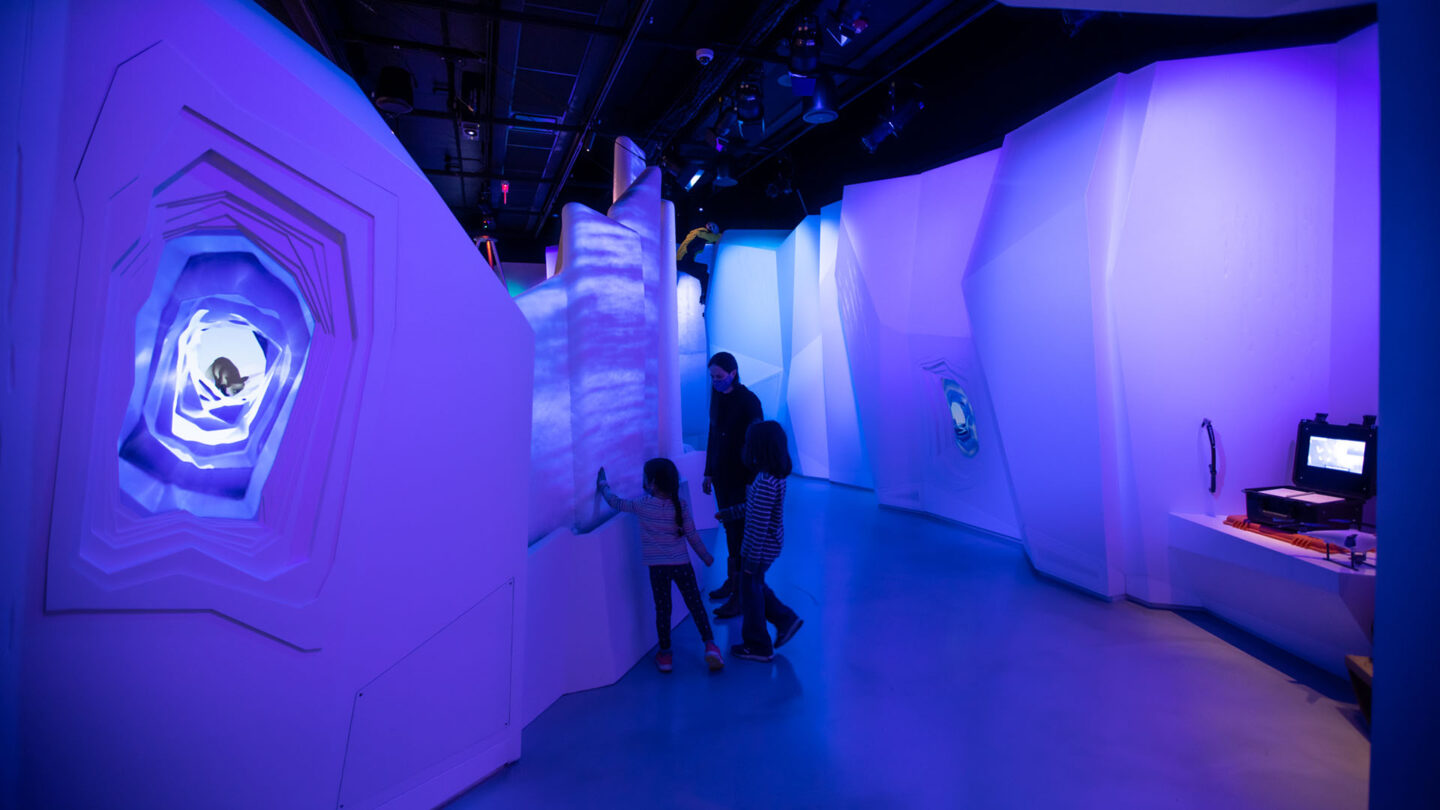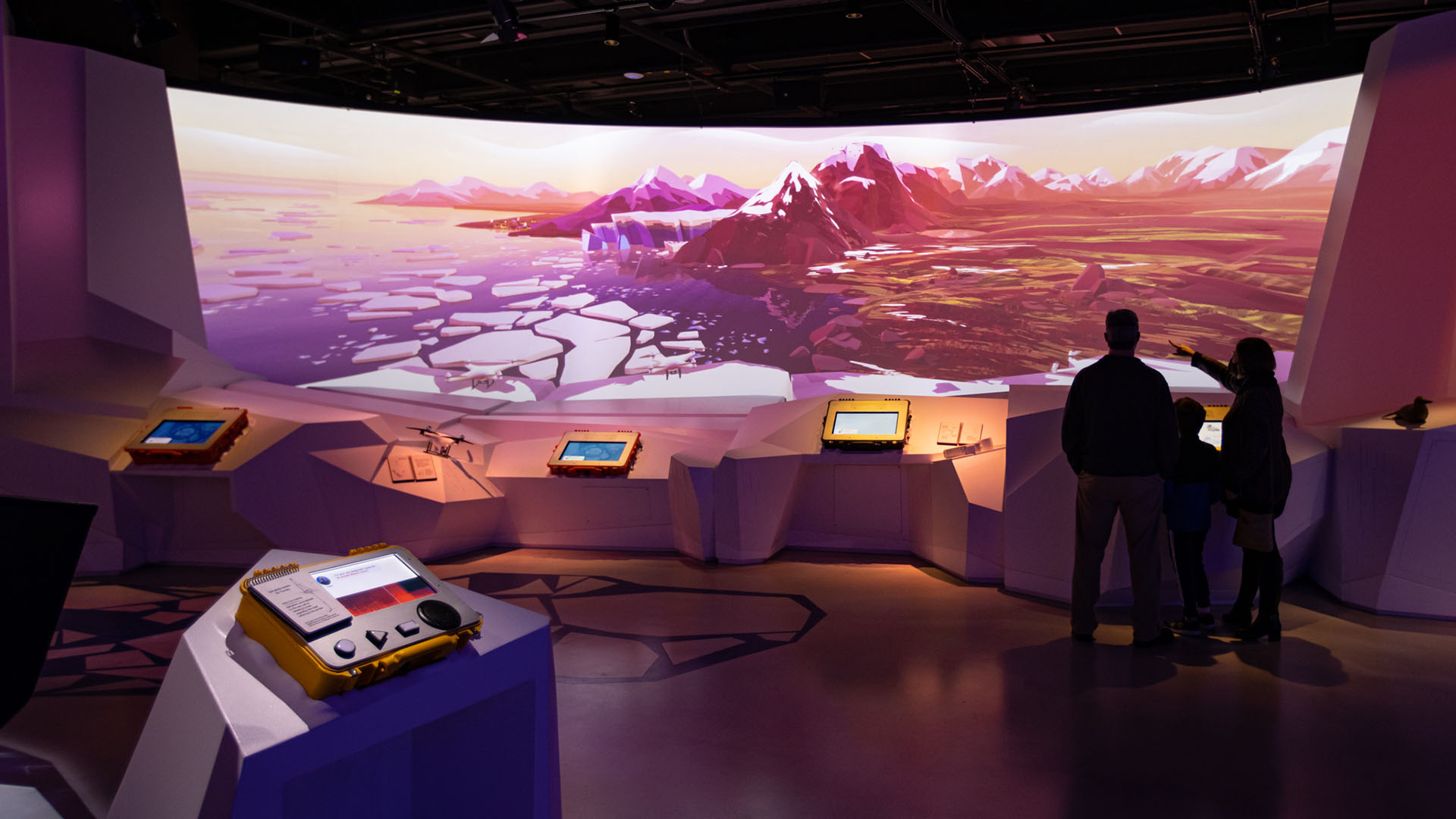Arctic Adventure: Exploring with Technology
The experience illustrates how our global climate is changing through diverse augmented learning zones that empower visitors to undertake research with the aim of comprehending how climate history is recorded in the ice. A dynamic and immersive exhibition invites visitors to learn through play, becoming polar explorers who trek across virtual ice fields with ground-penetrating radar and search for wildlife with interactive tools.
Agency
Moment Factory
Practice Area
Client
The Museum of Science, Boston
Industry

The Challenge
Encouraging visitors to interact with real technologies used by researchers to explore and measure climatic changes in the Arctic would empower them to play an active role in the exhibit and better understand the various uses and limitations of these technologies. Focusing the design of the exhibit around the visitor’s experience, Arctic Adventures would allow visitors to uncover information, learn and discover at their own pace.
Project Vision
By leveraging cutting-edge light, sound, visuals, and interactive technologies, the team was able to create a dynamic and immersive exhibition that invites visitors to learn through play. Arctic Adventures would feature four distinct zones that each foster unique opportunities for intuitive learning.
The Museum of Science, Boston established several key success factors that guided the project, from the selection process of the Exhibit Design Team through the stages of conception, final design and implementation of the environment

Bordering MOS’s iconic Blue Wing atrium, the exhibit’s eye-catching dynamic signage invites visitors into the experience while offering glimpses of the zones within.
Moment Factory

Visitors traverse an ice cave where a real ice wall can be touched and scientific tools (drones, hydrophones, GPS) are introduced using interactive props.
Moment Factory

The control system syncs interactive game engines, immersive soundscapes and dynamic lighting hues to support a seasonal day cycle of the ever-evolving Polar North landscape.
Moment Factory

Designers strived to provide a variety of accessible, interactive activities; in the Animals zone, visitors search for wildlife in the Open Vista or listen for animals underwater.
Moment Factory
Design + Execution
The design solution for Arctic Adventures was born from the cross-pollination of several media, inspired by video game storyworlds, game-engine design, interactive technology and large-scale video projection to create living, breathing environments that respond to visitors in real time. This interdisciplinary approach was founded on engaging the visitor through immersive storytelling techniques, encouraging discovery using gamified exhibition design and empowering visitors with hands-on experience manipulating technology. These pillars work seamlessly to demonstrate how visitors gain meaningful learnings through play.
A key element involves providing visitors opportunities to directly handle many technologies used in Arctic research, deepening their understanding of the constraints and capabilities of each technology. One such example takes place in the Navigating zone, where visitors must work in teams to maneuver a glacier and avoid letting equipment fall into the crevasses. Equipped with ground-penetrating radar and satellite maps, visitors apply real-life technologies and data to uncover crevasses hidden under the glacier’s surface. To heighten the sense of realism and foster collaboration, visitors must collaborate to locate each crevasse and cache. By adding elements of communication and risk, visitors are immediately engaged in the experience. Ultimately, all of the design solutions work together to foster an emotional connection with the exhibition content and shape an unforgettable visitor experience.

The interdisciplinary approach encourages visitors to explore and engage with interventions through storytelling, gamification and participation, allowing for a playful and educational experience.
Moment Factory

Designers maximized educational content and visitor flow by creating cohesive yet distinct zones and messaging. The curved panorama’s projection screen is visible front & back, providing an active/passive surface.
Moment Factory

Navigating glacier ice: partnering to use satellite imagery & ground penetrating radar to avoid crevasses and locate equipment caches. The drone panorama serves as a backdrop.
Moment Factory
Project Details
Often we separate media from its environment. This project did such a wonderful job of integrating the media into the space and making it feel like a natural and organic experience.
I like how the media is integrated into the setworks. It creates a truly immersive space where the content and not the medium is the most important part of the experience. I liked that they included sound and dynamic lighting to enrich visitors experience because this is something often overlooked in the visual planning process.
This project transforms the space of the museum and creates an entirely new environment, down to a wall of real ice. The digital and physical landscapes blend together in an organic way that encourages exploration and discovery.
Design Team
Museum of Science, Boston
Moment Factory
Collaborators
Adirondack Studios (scenographic decor fabrication & installation)
Photo Credits
Moment Factory (photography)
Open Date
December 2020




